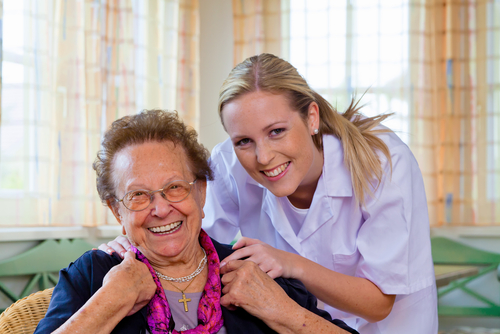5. Correspondence and documentation
| Site: | StudentWeb |
| Course: | 2025 Communicate and work in health or community services (VDSS_CHCCOM005) |
| Book: | 5. Correspondence and documentation |
| Printed by: | Guest user |
| Date: | Friday, 15 August 2025, 11:12 PM |
Description

Table of contents
- 1. Reporting and documenting
- 2. Industry terminology
- 3. Clear, accurate and objective language
- 4. Learning activity
- 5. Gathering information
- 6. Behaviour changes
- 7. Workplace policies and procedures
- 8. Reporting issues
- 9. Organisational reporting technologies
- 10. Digital media
- 11. Communicating effectively with healthcare professionals
1. Reporting and documenting

Part of your role is to take reasonable care of your own health and safety in the work environment as well as the health and safety of others. Documenting and reporting is essential for ensuring health and safety. Remember that when you respond to a potential or actual risk, you must not place yourself or others at risk.
You have an obligation to:
- take reasonable care to protect your own health and safety
- not adversely affect the health and safety of others (including patients,clients,residents and other workers)
- use the equipment provided by the employer to protect your health and safety
- follow reasonable instructions on health and safety
- read workplace documentation relating to your role
- seek clarification and further understanding from your supervisor, if necessary.
1.1. Managing potential risks
You can manage potential risks by continuously asking yourself:
- What can go wrong?
- Am I certain that I am aware of all possible risks?
- What will I do to prevent each risk?
- What will I do to handle the risk if the risky event happens?
As an AHA, you must document any incidents, observations or concerns and discuss these with your supervising AHP. In workplaces where reports such as incident reports or progress notes are in hard copy, make sure your handwriting is neat and easy to read. It’s also important that reports are written in clear English and in black pen.
Here is a list of some of the types of documents you may use as an AHA in a health or community setting:
- case or progress notes
- individual care plans
- exercise program records
- incident and hazard reports
- handover/referral from an AHP
- handover to an AHP
- equipment loan and purchase records
- attendance records.
2. Industry terminology
It is important that you use correct industry terminology in verbal, written and digital communications in your work role.
Note that abbreviations used in documentation may differ between healthcare organisations. It is important to only use approved abbreviations in your documentation whilst you are a student on placement and when you are working as an AHA. Orientation to an approved abbreviation list should be completed during workplace induction.
This table explains some of the most common acronyms and abbreviations you will encounter.
| Acronym/abbreviation | Definition | Acronym/abbreviation | Definition |
|---|---|---|---|
| 1/7 | One day | Max | Maximal |
| 1/12 | One month | Min | Minimal |
| 1/52 | One week | Mob | Mobilise |
| 4PS | Four point stick | Mod | Moderate |
| 4WF | Four wheeled frame | N + V | Nausea and vomiting |
| 4WW | Four wheeled walker | O | Objective |
| A | Action | OTF | Over toilet frame |
| ADL | Activity of daily living | P | Plan |
| AM | Morning | pADL | Personal activity of daily living |
| Ax | Assessment | PHx | Past history |
| Ax1 | One person assist | PM | Afternoon |
| Ax2 | Two person assist | Pt/pt | Patient |
| c/o | Complains of | PUS | Pick up stick |
| cADL | Community activity of daily living | Px | Pain |
| CHx | Current history | ROM | Range of motion |
| dADL | Domestic activity of daily living | Rx | Treatment |
| Ex | Exercise | S | Subjective |
| GF (also known as FASF) | Gutter frame (or forearm support frame) | S/v | Supervision |
| HEP | Home exercise plan | SHx | Social history |
| HOPC | History of presenting complaint | SPS | Single point stick |
| I | Independent | SS | Shower stool |
| Mane | In the morning | w/c | Wheelchair |
2.1. Written communication
Progress notes are uses to record any intervention that you perform with a patient/resident. The standard format is SOAP (Subjective, Objective, Assessment, and Plan). This documentation must be completed at the time of the intervention.
While an incident report is incident focused, progress notes are resident/patient focused. For example, if you saw Mr O’Connell fall, you would follow the protocol for a fall. This incident would require immediate consultation with your supervising AHP and the completion of an incident report. You would also record a progress note about Mr O’Connell’s fall and the actions you took.
The AHP would be responsible for any updating of Mr O’Connell’s care plan, such as that he may need more support /closer supervision when walking.
Care plans are documents that address the consumer’s needs including:
- medical
- nursing
- mental
- psycho-social
- emotional
- spiritual
- physical.
Important
Don't forget how important it is to have good grammar in your written communications, and likewise the importance of speaking at the appropriate speed and pronunciation for verbal communication.
3. Clear, accurate and objective language

Used under licence with shutterstock.com. Added 10/01/2024
A key part of your role as an AHA is to document treatments/interventions and incidents or other such information. It is therefore imperative that the language you use in this documenting is clear, accurate and objective in its nature.
It is commonly understood that everyday language is inherently 'subjective'. Meaning it often expresses opinions based on personal values, beliefs or preferences of the writer rather than the evidence. Opinions tend to be based on subjective judgment rather than information that can be verified.
'Objective' language, on the other hand, is considered to be language that is impartial, which is not personal, judgemental or emotive. It is therefore considered to be fair and accurate. It avoids exaggeration and bias and shows respect for the views of others.
Important
Stick to the facts, do not make personal judgements. (e.g. ‘Dot smelled strongly of urine’ NOT ‘Dot was incontinent’. Dot may smell of urine because she sat in a chair where someone else had urinated)Source: Objective Language, Writing Centre Learning Guide, The University of Adelaide
4. Learning activity
Learning Activity
Review the SOAP note format that is utilised widely in allied health documentation. Here is a document from Queensland Health: Guidelines for allied health assistants documenting in health records (opens in new window).
What do each of the sections contain ?
- S
- O
- A
- P
5. Gathering information

Being an informed AHA prepares you with knowledge on how to deliver quality, person-centred care. Incorporating this information into your care is vital. Every interaction you have with patients/consumers, their family and friends, other personal care attendants and your supervisor provides you with an opportunity to gather information that will assist you in your role. Discuss and confirm each person’s own preferences in a positive way.
Remember that each individual is a person with their own likes and dislikes, joys and sorrows, experiences and personality. Add any relevant knowledge you gain through a patient interaction to the patient's progress notes. Talk to your supervisor about any information gathered through informal discussions with a patient /client that may impact their care plan.
Alert
When sharing information, you must respect the privacy and dignity of the patient/resident.
Private and confidential information should be stored in accordance with your organisation’s policies and procedures.
6. Behaviour changes

Policies and procedures are essential for safe and effective care and exist to support staff in their roles working with all client groups. It is important to locate and familiarise yourself with your organisation’s policies and procedures for changed behaviour management and de-escalation procedures. You must alert your supervisor of any changes in a client's behaviour.
When noting behavioural changes in a client you will need to discuss this with your supervising AHP.
This will include information such as:
- the changed behaviour(s)
- the physical and psychological risks associated with the behaviour displayed
- possible triggers that may have led to the changed behaviour
- strategies that will address these triggers and reduce behaviours of concern.
Your supervisor will document the information you provide. Your supervisor will refer to these documents when communicating with other healthcare staff or the client’s family. Healthcare staff and the client's family will be informed of the client's changed behaviours and any incidents that have occurred and involved in the development of strategies to manage these new behaviours.
Organisations will have policies and documents to record and manage behaviour:
- Individual Care Plans - Behaviour Management section
- Behaviour Monitoring Logs
- Behaviour Assessment and Management Strategies
- Progress Notes.
7. Workplace policies and procedures

Being aware of your organisation's policies and procedures is extremely important. These documents are designed to provide clear guidelines and advice for all staff in how they conduct their roles and how the organisation is operated. Here are some guidelines to help you:
- Read your position description and seek clarification from your supervisor if you are unclear of anything.
- Complete documentation to legal requirements and organisation procedures.
- All documentation (written and electronic) must be completed to organisation standards.
- Use language that is clear and accurate.
- Follow policies regarding digital and social media.
8. Reporting issues
The following are examples of when your direct supervisor MUST be notified:
- Any significant change in the patient/client in your care
- When you are unable to complete the AHPs prescribed intervention
- Any incident occurs
- If there is a breach or non-adherence to standard procedures
- Conflict situations that are unable to be resolved
- There are issues or you are having trouble adhering to your legal and ethical responsibilities
- There are issues that make it difficult to maintain the rights and responsibilities of the consumer, yourself, another employee or colleague or your employer.
9. Organisational reporting technologies

Organisational reporting technologies are the tools used to document, report and store information about residents/patients.
When keeping records, the organisation is likely use a mixture of paper (hard copy) and digital (soft copy) documentation. There is no standard or uniform way and different organisations will use different methods. Some will rely more on paper whilst others will rely more on digital reporting technologies. Regardless, all of them are required to meet legal and ethical requirements.
Each organisation is responsible for their policies and procedures which outline exactly how you will need to deal with legal and ethical requirements. It is your responsibility to ensure that you follow the policies and procedures. Digital record keeping and documenting is becoming more common than the traditional method of having a hard copy stored in a filing cabinet.
You must also follow the organisation's communication policies and procedures for using digital media. These policies and procedures often detail lines of communication, procedures for dealing with conflict and issues, plus guidelines on the use of digital and social media.
Many organisations do not allow their staff to make comments about the workplace on digital or social media. You must ensure you have read and clearly understood the requirements.
10. Digital media

Digital media is used in community services and the health sector in the following ways:
- web-based information (in particular websites which may contain consumer-focused information such as information and newsletters, plus internal documentation for use by staff such as policies and procedures)
- email (internal and external official communication channel)
- social media (publicity and social sites for connecting with consumers, family and others)
- podcasts and videos (this information can be housed on a website and maybe internally focused, such as training videos for staff or externally focused with podcasts of interest to consumers)
- tablets and applications (these may be used in the facility as a means of engaging consumers with technology, additionally they may be used in a professional setting for staff)
- newsletters and broadcasts (these may be internal for staff consumption or external for consumers, family and friends)
- intranet (typically an internal network which allows staff to access important information, policies and procedures plus access to documents and consumer files).
Reference: The Medical Device Research Institute, Flinders University and the Aged Care Industry IT Council (ACIITC) have put together a paper called the Aged Care Technology Roadmap. The paper addresses the need for facilities to use digital technologies to help improve efficiencies for staff and the overall experience for residents. By the end of this course, you will have covered the types of documentation and reporting and their importance with some digital examples of what they could look like.
10.1. Organisation digital media communication policies and procedures
Following your organisation's communication rules for using digital tools means adhering to guidelines when using things like email, messaging apps, or online health records to communicate at work. In allied health, this helps make sure that communication is safe, professional, and follows legal and ethical standards, like keeping client information private and secure.
Example:
An Allied Health Assistant (AHA) may be required to email a client’s exercise plan to a physiotherapist for review. Before doing so, they must follow the organisation’s communication policies to ensure that sensitive information is shared securely. This could involve:
- Using approved email platforms (encrypted systems or secure portals).
- Including only relevant details, avoiding unnecessary personal information.
- Obtaining client consent before sharing any personal health information digitally.
- Following privacy laws, such as the Privacy Act 1988, to protect the confidentiality of client data.
By following these procedures, the AHA ensures that all communication using digital media is secure, aligns with organisational policies, and respects client privacy, while maintaining the integrity of professional communication within the healthcare team.
The Roo Health Using Digital Media Policy and Procedure (located in the Roo Health Hub) outlines the procedures for Allied Health Assistants (AHAs) to follow workplace communication policies and procedures when using digital media.
10.2. Learning activity
Learning Activity
The next time you are in any workplace, ask questions to learn more about their use of technology. These technologies include computers, tablets, as well as software and apps. It could be as simple as emails and typed documents in Word, or it might be something more advanced, such as online forms, online collaboration tools or a specific software designed for the organisation.
Some things to think about when asking about technology in your workplace.
- Does the use of digital technology:
- Reduce risks and improve security and confidentiality?
- Help staff to work smarter?
- Streamline processes and improve efficiencies?
- Increase consistency and reduce compliance and safety risks?
- Enhance communication amongst staff or residents and their families?
11. Communicating effectively with healthcare professionals

Sound processes are critical for effectively communicating aspects of anatomy and physiology in delivering care.
These include:
- Reading and understanding information that is communicated by a colleague, documented in clients’ health records or included in a handover.
- Documenting therapy sessions in the client's health record.
- Being able to understand and deliver a handover of relevant information to colleagues.
To make communication between health professionals as effective as possible many useful tools are available.
Commonly used formats include ISBAR for structured handover and the SOAP note for documentation in the client record.
For more information, go to (open in new windows):
Allied health assistant core competency: communication of client information - Learning package | Department of Health VictoriaGuidelines for allied health assistants documenting in health records — Allied Health Professions’ Office of Queensland | Queensland Health